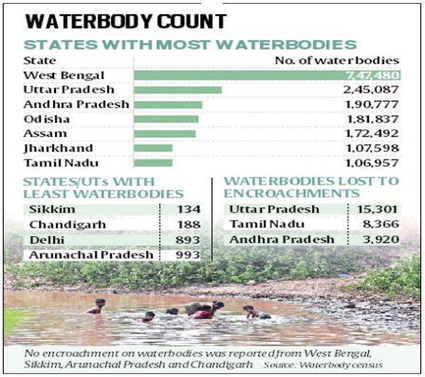Why in News?
- The Union Ministry of Jal Shakti has launched the first-ever census of water bodies in convergence with the Sixth Minor Irrigation Census (reference year 2017-18), under the Centrally Sponsored Scheme – “Irrigation Census”.
- The objective of the census is to develop a national database for all water bodies by collecting information on all important aspects including their size, condition, status of encroachments, use, storage capacity, etc.
What’s in Today’s Article?
- What is a Water body?
- What are the Key Highlights of the First-ever Census of Water bodies?
- Steps for Augmentation, Conservation and Efficient Management of Water Resources
What is a Water body?
- The census defines a water body as all natural or man-made units bounded on all sides with some or no masonry work used for storing water for
- Irrigation or
- Other purposes (example industrial, pisciculture, domestic/drinking, recreation, religious, groundwater recharge, etc).
- Water bodies are usually of various types known by different names like tank, reservoirs, ponds and bundhies, etc.
- A structure where water from ice-melt, streams, springs, rain or drainage of water from residential or other areas is accumulated will also be treated as a waterbody.
What are the Key Highlights of the First-ever Census of Water bodies?

- 24,24,540 water bodies have been enumerated in the country, out of which 97.1% (23,55,055) are in rural areas and only 2.9% (69,485) in urban areas.
- The data of water bodies up to the fifth minor irrigation census is limited to village level whereas the first census of water bodies covers all types of water bodies in both rural and urban areas.
- 59.5% (14,42,993) of water bodies are ponds, followed by tanks (15.7% i.e., 3,81,805), reservoirs (12.1% i.e., 2,92,280), water conservation schemes/percolation tanks/check dams (9.3% i.e. 2,26,217), lakes (0.9% i.e. 22,361) and others (2.5% i.e. 58,884).
- West Bengal accounts for the most (7.47 lakh) and Sikkim the least (134) number of water bodies.
- West Bengal has the highest number of ponds and reservoirs, whereas Andhra Pradesh has the highest number of tanks.
- Tamil Nadu has the highest number of lakes and Maharashtra is the leading state with water conservation schemes.”
- West Bengal’s South 24 Parganas has been ranked as the top district having the highest (3.55 lakh) number of water bodies across the country.
- The census also collected data on encroachment of water bodies for the first time.
- 1.6% water bodies are reported to be encroached, out of which 95.4% are in rural areas and remaining 4.6% in urban areas.
Steps for Augmentation, Conservation and Efficient Management of Water Resources:
- Water being a State subject, steps are primarily undertaken by the respective State Governments.
- In order to supplement their efforts, the Central Government provides technical and financial assistance through various schemes and programmes.
- For example, Repair, Renovation and Restoration (RRR) of Water Bodies under Pradhan Mantri Krishi Sinchayee Yojana (PMKSY)- Har Khet Ko Pani (HKKP) scheme provides for the restoration of water bodies.
- There is the need for taking necessary steps for keeping all the water bodies encroachment free, such as
- Inclusion of water bodies in land records,
- Making them integral part of town planning process,
- Strict action for the encroachers, etc.










